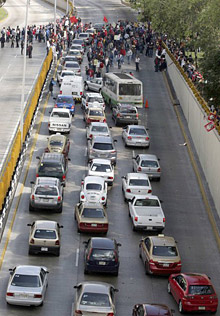
|  |  |  News Around the Republic of Mexico | November 2009 News Around the Republic of Mexico | November 2009  
In Mexico, Tying the City in Knots is a Capital Idea
 Ken Ellingwood - Los Angeles Times Ken Ellingwood - Los Angeles Times
go to original
November 13, 2009


| | Some of the 200,000 demonstrators who turned out to protest the closing of a utility cut off vehicles on a Mexico City street. (Daniel Aguilar/Reuters) |  |
Tens of thousands of protesters angry about a utility's shutdown bring traffic to a halt. So what else is new?

Mexico City - Take world-class traffic congestion. Add protesters, tens of thousands of them, until streets become a thick, impenetrable mass. Let angry horn-blowing begin. Repeat, over and over.

There are times in Mexico's teeming capital when you can't get there from here. Usually, it's a question of too many cars on too few streets. But on many other days - Wednesday, for example - the paralysis is caused by street demonstrations, which are as worthy an emblem of Mexico City as the Angel of Independence statue on Paseo de la Reforma, where marchers often gather.

This time, the demonstrators were fired electrical workers and their backers from 700 civic and labor groups, a major event even by Mexico City standards. Authorities estimated that 200,000 people assembled at various protest sites, and about half of those joined the march.

Starting at daybreak, protesters blocked key highways and rallied at strategic points throughout the downtown area to denounce the shutdown last month of a state-run utility that supplied power to the capital and employed 44,000 electrical workers.

By afternoon, crowds of demonstrators had in effect stilled Paseo de la Reforma, the city's monument-studded main boulevard.

On one central stretch near downtown, throngs of protesters set out from the independence statue for the Zocalo, or central plaza. On a separate section a mile or so away, scores of union members used cars and buses to block the boulevard in front of famed Chapultepec Park. As bewildered tourists looked on, electrical workers shut off their engines and blared recorded messages criticizing President Felipe Calderon's move to disband the utility, Luz y Fuerza del Centro.

Several arrests were reported amid scattered confrontations between protesters and police. Outside the city, federal police fired tear gas to clear fired electrical workers from two major highways. At least two officers were reported injured when they were struck by cars at one of the highway protests.

The Mexican Electrical Workers Union says Calderon acted illegally when he closed Luz y Fuerza, or Light and Power. Activists characterize the move as a threat to Mexican labor that is part of a wider plan to privatize state-owned enterprises, such as oil.

Calderon said he shut down the utility because it was inefficient and its services were too expensive to keep subsidizing. Luz y Fuerza served 24 million customers in the capital and parts of four nearby states. Another government agency, the Federal Electricity Commission, took over.

This latest protest-induced mess left motorists to grit their teeth and try to cope - yet again. Some schools, including several universities whose unionized employees were taking part in the demonstration, canceled classes. Mexico City Mayor Marcelo Ebrard summoned top aides to a war room to monitor the situation.

Workers across the city changed their schedules or plotted new routes to their jobs. Mexican newspaper websites posted color-coded maps to steer readers away from clogged zones. Helicopters buzzed all day. News coverage sounded like one giant SigAlert.

"It's awful," said Fernando Gomez, who in 30 years as a Mexico City taxi driver has maneuvered around more demonstrations than he can count. "It's your job to put up with traffic, but there are times when you say, 'I'm not going out.' "

Early in the day, as protesters assembled, Gomez was already planning his avoidance behavior. He said he would work from a taxi stand far away from the march.

"They shouldn't allow so many" demonstrations, he said. "They affect everybody."

Name the cause, there's been a demonstration about it on picturesque Paseo de la Reforma. Teachers and firefighters have marched for better pay. Farmworkers on tractors have demanded government help. Protesters from Veracruz camped out for months, half-naked, to draw attention to an obscure land dispute.

A favored tactic is stopping traffic, a move known as the bloqueo. In recent weeks, avenues and highways were shut down by angry university workers, unlicensed taxi drivers and residents upset about shortages of drinking water.

At the Angel of Independence statue, fired electrical worker Javier Lara - wearing a bald-crowned wig to evoke Miguel Hidalgo, the independence hero - and his jobless colleagues conceded that their action meant headaches for traffic-weary residents.

"It's not fair," Lara said. "But it's necessary to make the government understand."

ken.ellingwood(at)latimes.com
|

 |
|  |



